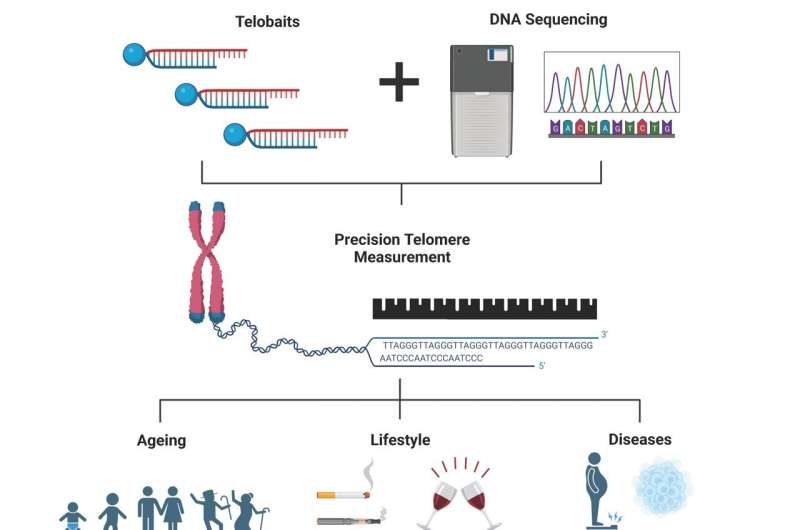This article has been reviewed according to Science X's editorial process and policies. Editors have highlighted the following attributes while ensuring the content's credibility:
fact-checked
peer-reviewed publication
trusted source
proofread
Novel method to accurately measure key marker of biological aging

Telomeres—the caps at the ends of chromosomes that protect our genetic materials from the brunt of cellular wear and tear—are known to shorten and fray over time. Lifestyle, diet and stress can exacerbate this process, leading to early loss of telomere protection and increasing the chances of early aging and diseases, such as cancer and heart disease.
To date, approaches for measuring biological aging based on telomere length have been limited as they can only ascertain average telomere lengths within a pool of DNA fragments, or they are time-consuming and require highly-skilled specialists. Being able to accurately and efficiently measure the length of an individual's telomeres could open the doors to developing lifestyle interventions that slow aging and prevent disease.
Publishing in the journal Nature Communications, scientists at Duke-NUS Medical School, National Heart Center Singapore (NHCS) and colleagues in Singapore, China and the U.S. have recently devised a way to rapidly and precisely measure the length of a single telomere.
Associate Professor Li Shang, senior author of the study from Duke-NUS Cancer & Stem Cell Biology Program, explained, "We applied a novel approach that uses DNA sequences—we call them 'telobaits'—to latch onto the ends of telomeres in large pools of DNA fragments, like fishing in pond. Then, with specific scissor-like enzymes, we snip the telomeres out of the pools.
"Using high-throughput genetic sequencing technology, we were able to read the DNA 'letters' that comprised each individual telomere, allowing us to very precisely measure their lengths."
The team successfully validated this approach when they tested it using human cell lines and patient cells. Interestingly, the sequencing results revealed that the genetic sequences within certain parts of the telomeres, known as telomeric variant sequences, were distinct to each individual person.
"Based on this insight, a future area of study for us is the possible use of telomeric variant sequences as a means of biological identification, which could potentially prove useful for expanding the field of forensic science," said Assoc. Prof. Li.
The team believes this new approach could be used as a predictive biomarker for human aging and disease at the individual level, as well as for population-level studies on the impacts of lifestyle, diet and the environment on human health.
Senior co-author of the study, Assoc Prof Angela Koh, who is Senior Consultant with the Department of Cardiology at NHCS and Associate Professor with the SingHealth Duke-NUS Cardiovascular Sciences Academic Clinical Program, remarked, "This method for telomere length measurement is an important advance in the field of aging research. From the clinical perspective, we view this as a very promising method for understanding clinical diseases associated with aging such as cardiovascular disease.
"Our partnership signifies what can be achieved by clinician-and-biomedical scientists to bring complex lab methods towards simpler, quantifiable methods that may be used in broader clinical labs in the future."
More information: Cheng-Yong Tham et al, High-throughput telomere length measurement at nucleotide resolution using the PacBio high fidelity sequencing platform, Nature Communications (2023). DOI: 10.1038/s41467-023-35823-7
Journal information: Nature Communications
Provided by Duke-NUS Medical School
















